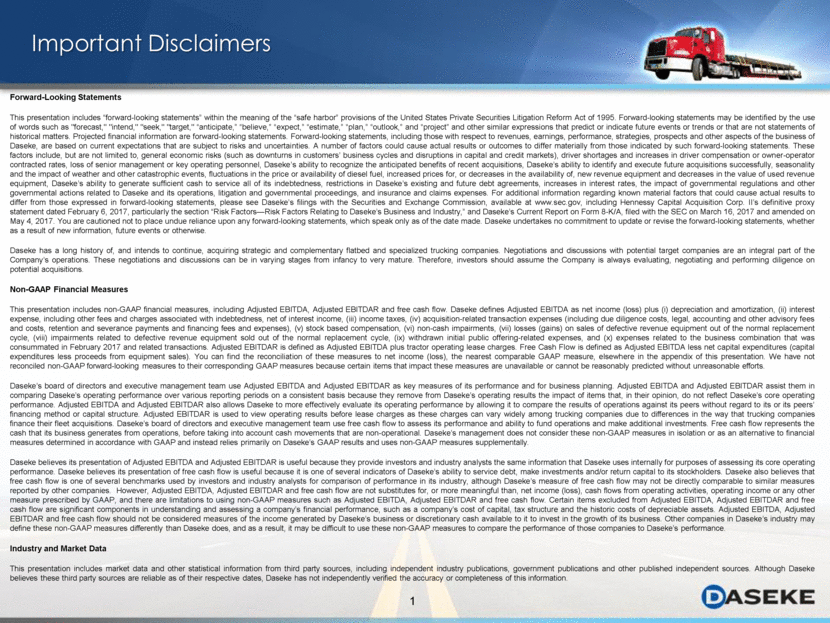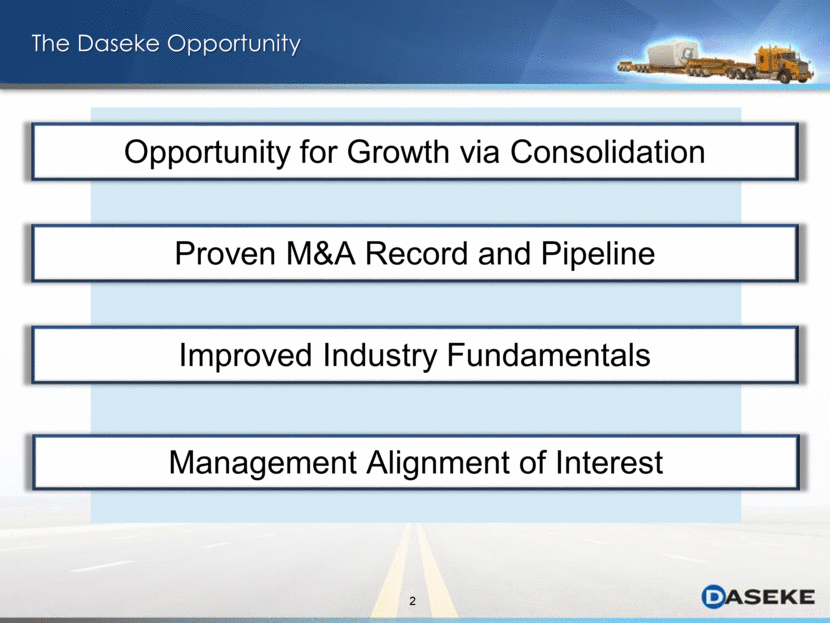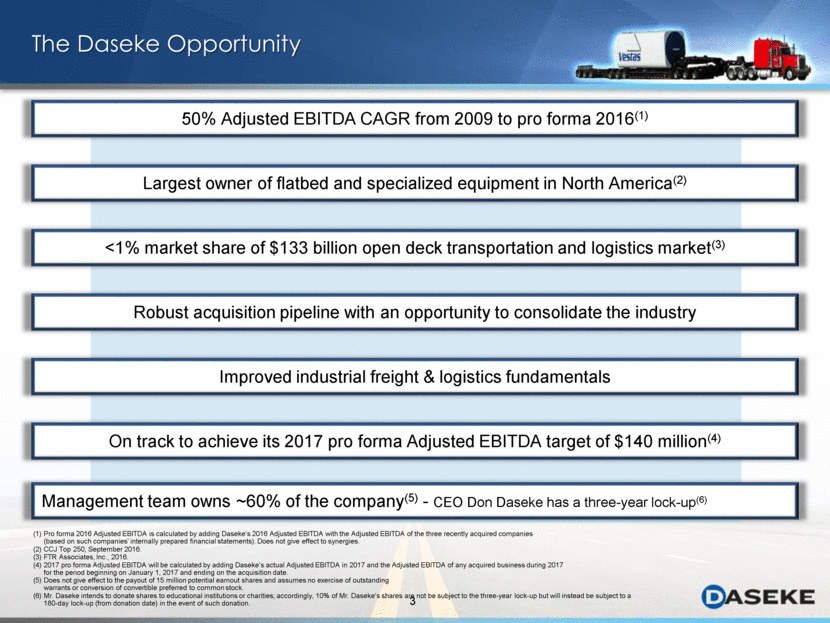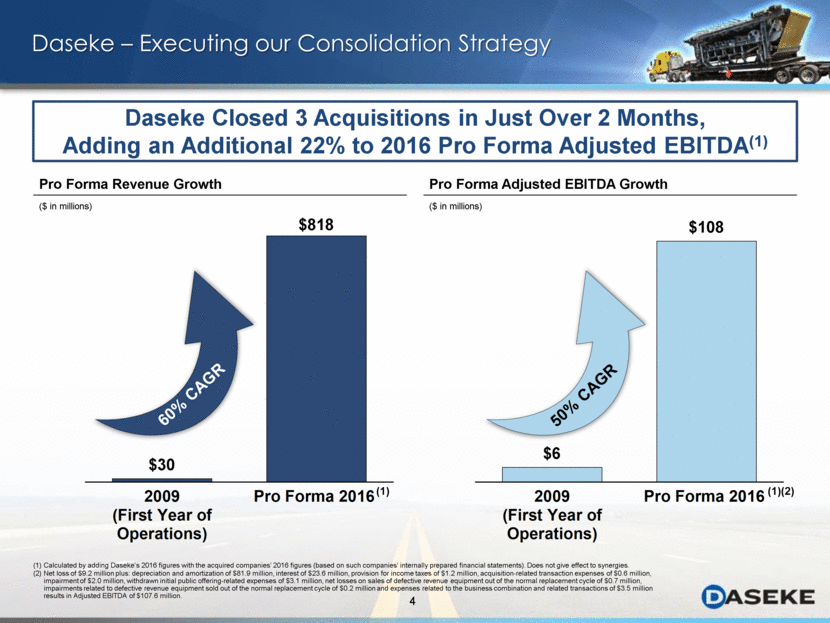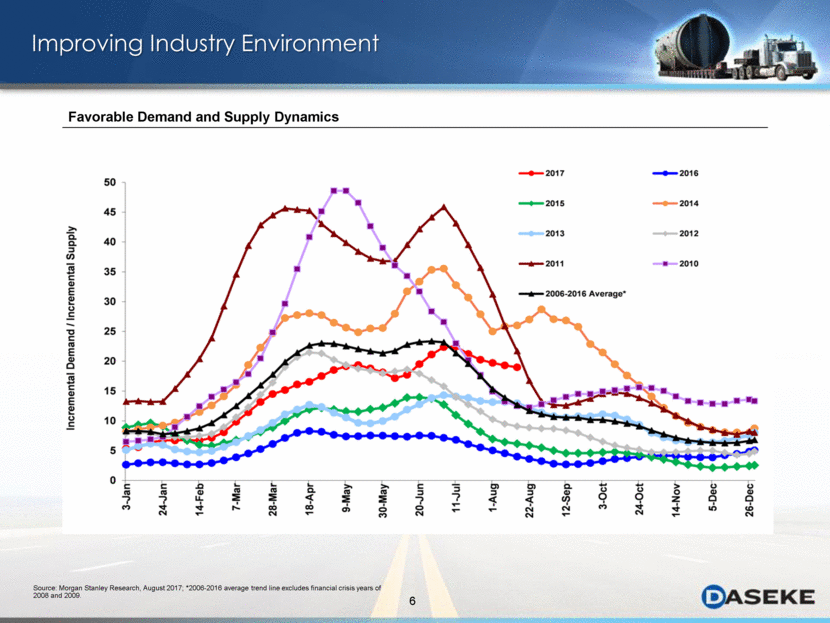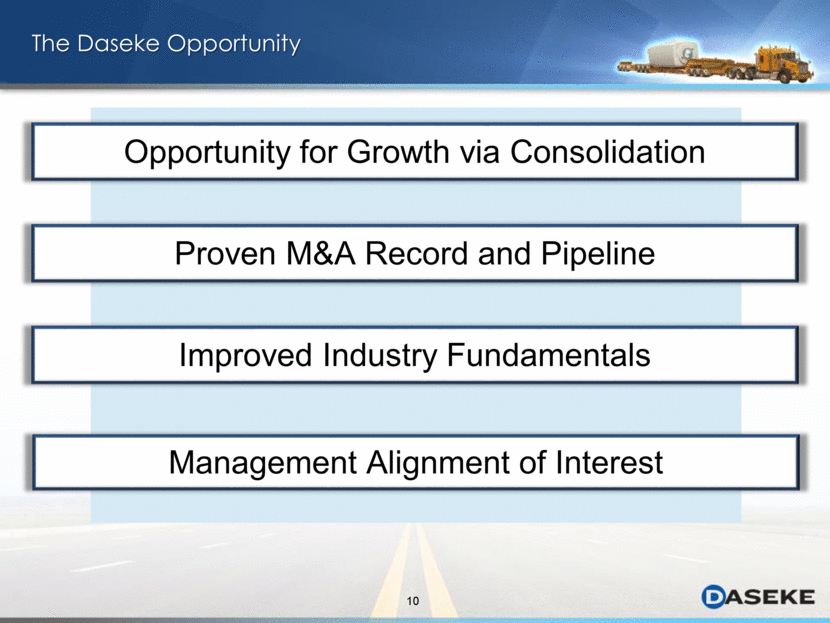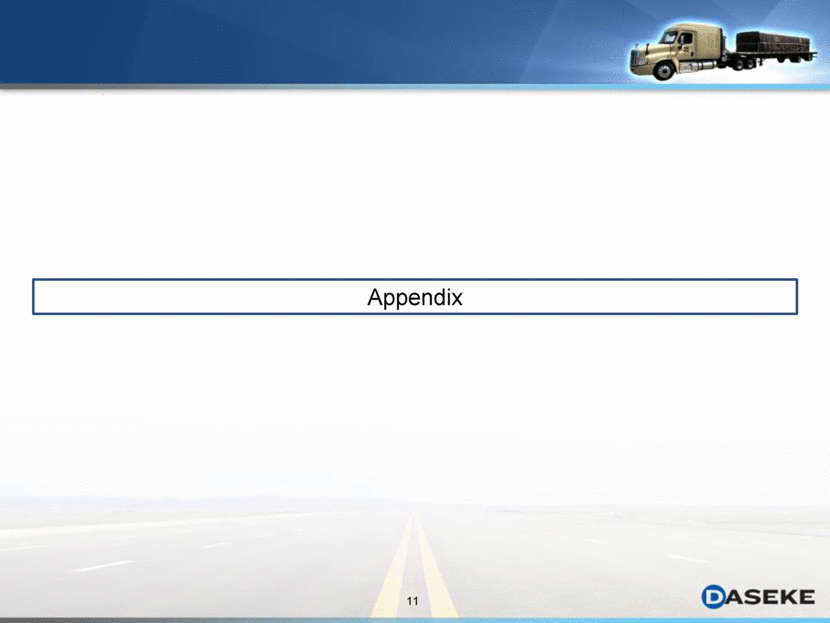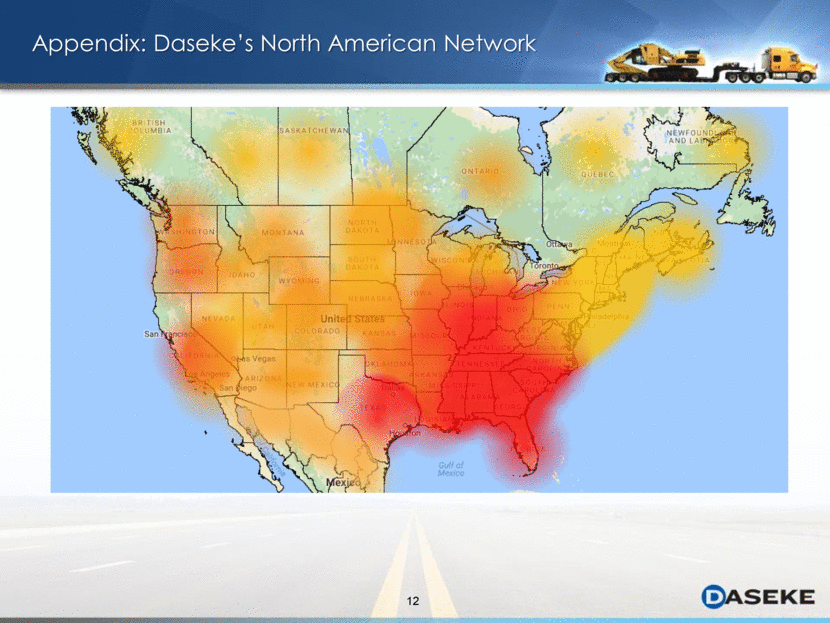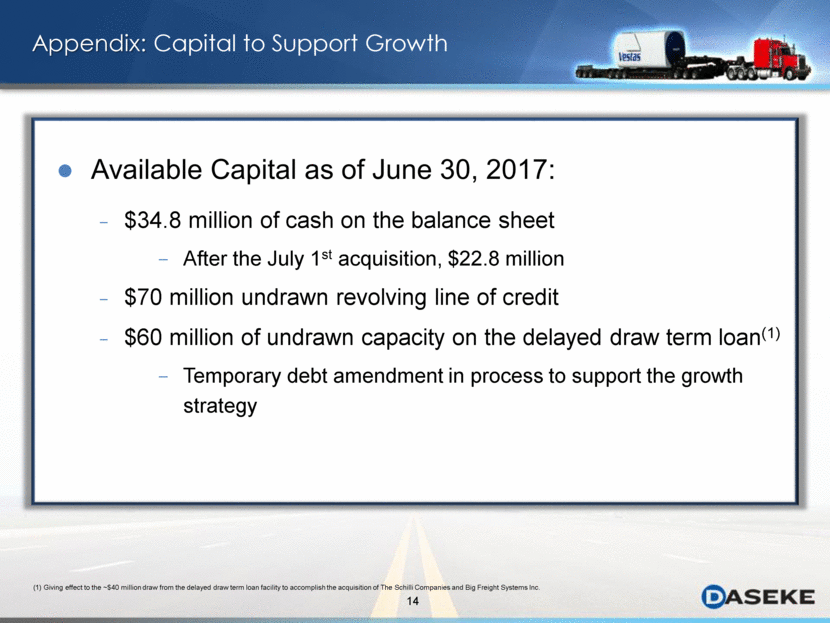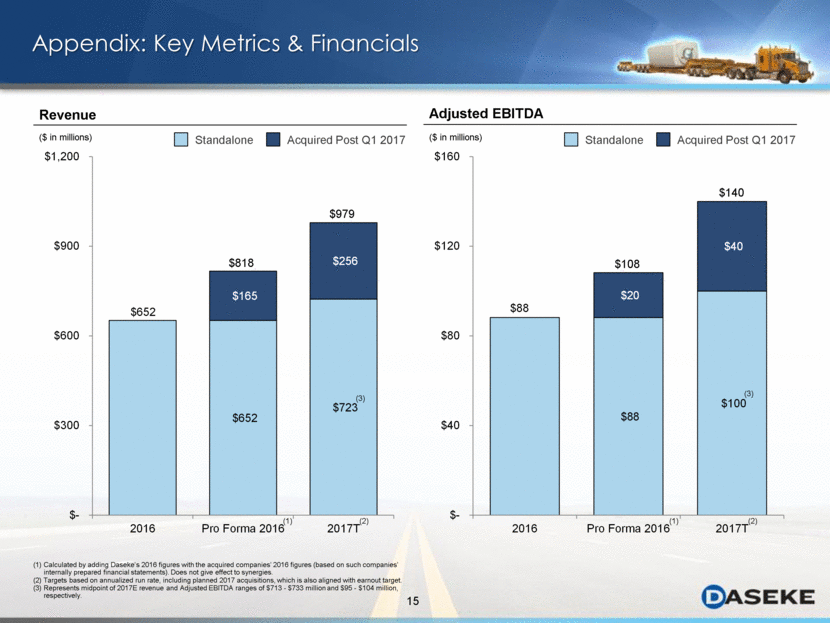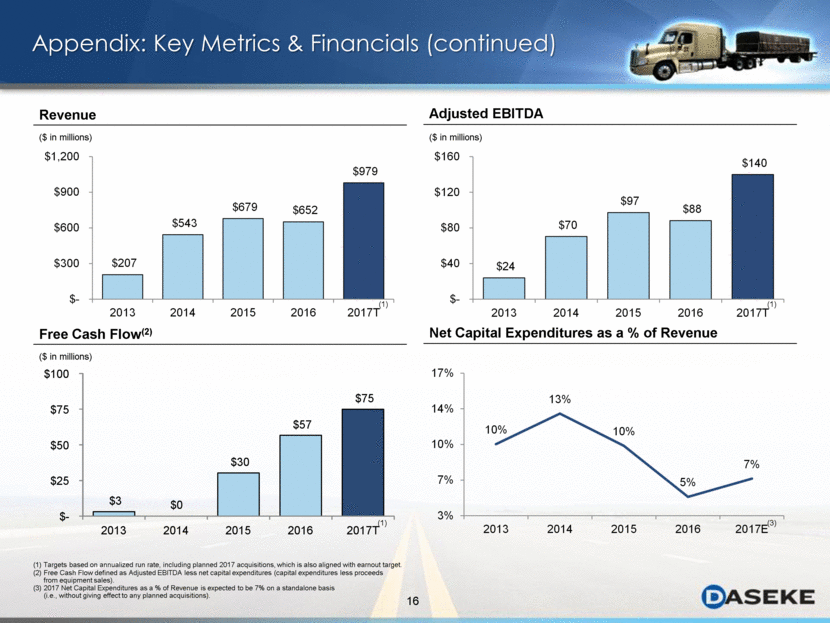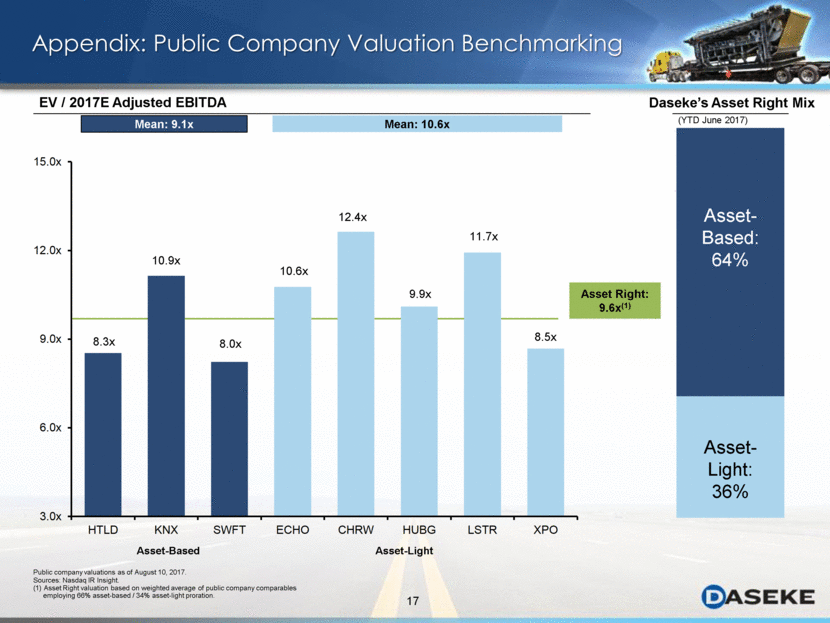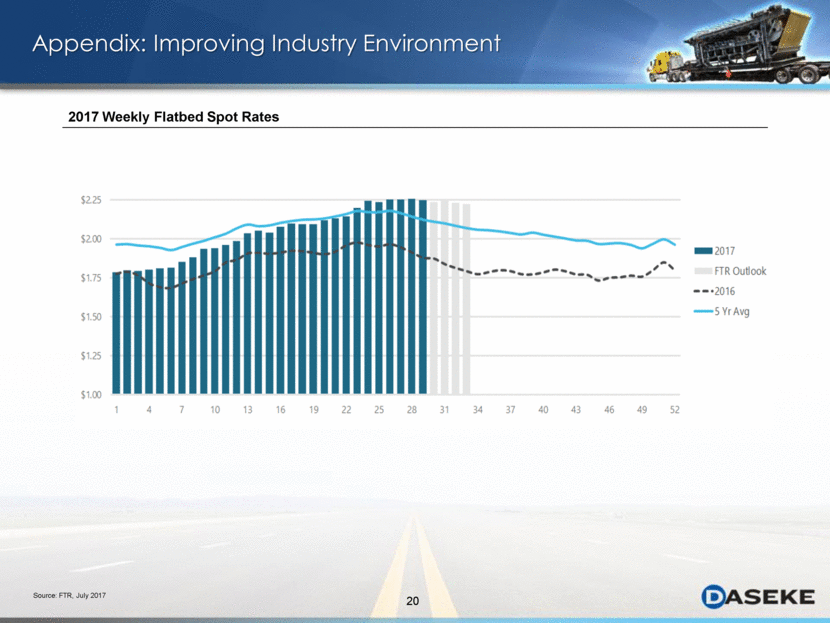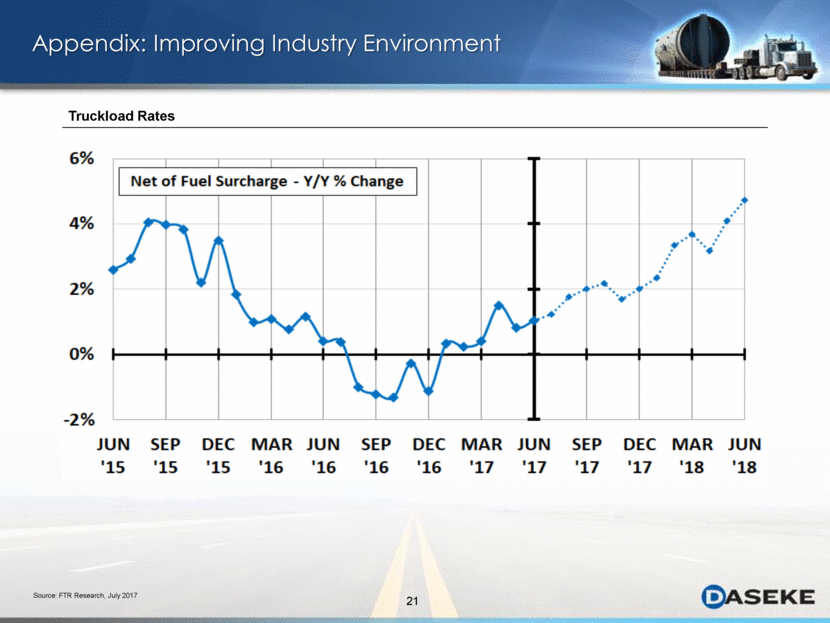Attached files
| file | filename |
|---|---|
| 8-K - 8-K - Daseke, Inc. | f8-k.htm |
Exhibit 99.1
|
|
Investor Presentation Daseke, Inc. – Consolidating North America’s Flatbed & Specialized Logistics Market August 2017 |
|
|
Forward-Looking Statements This presentation includes “forward-looking statements” within the meaning of the “safe harbor” provisions of the United States Private Securities Litigation Reform Act of 1995. Forward-looking statements may be identified by the use of words such as "forecast," "intend," "seek," "target," “anticipate,” “believe,” “expect,” “estimate,” “plan,” “outlook,” and “project” and other similar expressions that predict or indicate future events or trends or that are not statements of historical matters. Projected financial information are forward-looking statements. Forward-looking statements, including those with respect to revenues, earnings, performance, strategies, prospects and other aspects of the business of Daseke, are based on current expectations that are subject to risks and uncertainties. A number of factors could cause actual results or outcomes to differ materially from those indicated by such forward-looking statements. These factors include, but are not limited to, general economic risks (such as downturns in customers’ business cycles and disruptions in capital and credit markets), driver shortages and increases in driver compensation or owner-operator contracted rates, loss of senior management or key operating personnel, Daseke’s ability to recognize the anticipated benefits of recent acquisitions, Daseke’s ability to identify and execute future acquisitions successfully, seasonality and the impact of weather and other catastrophic events, fluctuations in the price or availability of diesel fuel, increased prices for, or decreases in the availability of, new revenue equipment and decreases in the value of used revenue equipment, Daseke’s ability to generate sufficient cash to service all of its indebtedness, restrictions in Daseke’s existing and future debt agreements, increases in interest rates, the impact of governmental regulations and other governmental actions related to Daseke and its operations, litigation and governmental proceedings, and insurance and claims expenses. For additional information regarding known material factors that could cause actual results to differ from those expressed in forward-looking statements, please see Daseke’s filings with the Securities and Exchange Commission, available at www.sec.gov, including Hennessy Capital Acquisition Corp. II’s definitive proxy statement dated February 6, 2017, particularly the section “Risk Factors—Risk Factors Relating to Daseke’s Business and Industry,” and Daseke’s Current Report on Form 8-K/A, filed with the SEC on March 16, 2017 and amended on May 4, 2017. You are cautioned not to place undue reliance upon any forward-looking statements, which speak only as of the date made. Daseke undertakes no commitment to update or revise the forward-looking statements, whether as a result of new information, future events or otherwise. Daseke has a long history of, and intends to continue, acquiring strategic and complementary flatbed and specialized trucking companies. Negotiations and discussions with potential target companies are an integral part of the Company’s operations. These negotiations and discussions can be in varying stages from infancy to very mature. Therefore, investors should assume the Company is always evaluating, negotiating and performing diligence on potential acquisitions. Non-GAAP Financial Measures This presentation includes non-GAAP financial measures, including Adjusted EBITDA, Adjusted EBITDAR and free cash flow. Daseke defines Adjusted EBITDA as net income (loss) plus (i) depreciation and amortization, (ii) interest expense, including other fees and charges associated with indebtedness, net of interest income, (iii) income taxes, (iv) acquisition-related transaction expenses (including due diligence costs, legal, accounting and other advisory fees and costs, retention and severance payments and financing fees and expenses), (v) stock based compensation, (vi) non-cash impairments, (vii) losses (gains) on sales of defective revenue equipment out of the normal replacement cycle, (viii) impairments related to defective revenue equipment sold out of the normal replacement cycle, (ix) withdrawn initial public offering-related expenses, and (x) expenses related to the business combination that was consummated in February 2017 and related transactions. Adjusted EBITDAR is defined as Adjusted EBITDA plus tractor operating lease charges. Free Cash Flow is defined as Adjusted EBITDA less net capital expenditures (capital expenditures less proceeds from equipment sales). You can find the reconciliation of these measures to net income (loss), the nearest comparable GAAP measure, elsewhere in the appendix of this presentation. We have not reconciled non-GAAP forward-looking measures to their corresponding GAAP measures because certain items that impact these measures are unavailable or cannot be reasonably predicted without unreasonable efforts. Daseke’s board of directors and executive management team use Adjusted EBITDA and Adjusted EBITDAR as key measures of its performance and for business planning. Adjusted EBITDA and Adjusted EBITDAR assist them in comparing Daseke’s operating performance over various reporting periods on a consistent basis because they remove from Daseke’s operating results the impact of items that, in their opinion, do not reflect Daseke’s core operating performance. Adjusted EBITDA and Adjusted EBITDAR also allows Daseke to more effectively evaluate its operating performance by allowing it to compare the results of operations against its peers without regard to its or its peers’ financing method or capital structure. Adjusted EBITDAR is used to view operating results before lease charges as these charges can vary widely among trucking companies due to differences in the way that trucking companies finance their fleet acquisitions. Daseke’s board of directors and executive management team use free cash flow to assess its performance and ability to fund operations and make additional investments. Free cash flow represents the cash that its business generates from operations, before taking into account cash movements that are non-operational. Daseke’s management does not consider these non-GAAP measures in isolation or as an alternative to financial measures determined in accordance with GAAP and instead relies primarily on Daseke’s GAAP results and uses non-GAAP measures supplementally. Daseke believes its presentation of Adjusted EBITDA and Adjusted EBITDAR is useful because they provide investors and industry analysts the same information that Daseke uses internally for purposes of assessing its core operating performance. Daseke believes its presentation of free cash flow is useful because it is one of several indicators of Daseke’s ability to service debt, make investments and/or return capital to its stockholders. Daseke also believes that free cash flow is one of several benchmarks used by investors and industry analysts for comparison of performance in its industry, although Daseke’s measure of free cash flow may not be directly comparable to similar measures reported by other companies. However, Adjusted EBITDA, Adjusted EBITDAR and free cash flow are not substitutes for, or more meaningful than, net income (loss), cash flows from operating activities, operating income or any other measure prescribed by GAAP, and there are limitations to using non-GAAP measures such as Adjusted EBITDA, Adjusted EBITDAR and free cash flow. Certain items excluded from Adjusted EBITDA, Adjusted EBITDAR and free cash flow are significant components in understanding and assessing a company’s financial performance, such as a company’s cost of capital, tax structure and the historic costs of depreciable assets. Adjusted EBITDA, Adjusted EBITDAR and free cash flow should not be considered measures of the income generated by Daseke’s business or discretionary cash available to it to invest in the growth of its business. Other companies in Daseke’s industry may define these non-GAAP measures differently than Daseke does, and as a result, it may be difficult to use these non-GAAP measures to compare the performance of those companies to Daseke’s performance. Industry and Market Data This presentation includes market data and other statistical information from third party sources, including independent industry publications, government publications and other published independent sources. Although Daseke believes these third party sources are reliable as of their respective dates, Daseke has not independently verified the accuracy or completeness of this information. Important Disclaimers |
|
|
The Daseke Opportunity Management Alignment of Interest Opportunity for Growth via Consolidation Proven M&A Record and Pipeline Improved Industry Fundamentals |
|
|
The Daseke Opportunity 50% Adjusted EBITDA CAGR from 2009 to pro forma 2016(1) Management team owns ~60% of the company(5) - CEO Don Daseke has a three-year lock-up(6) Improved industrial freight & logistics fundamentals Robust acquisition pipeline with an opportunity to consolidate the industry Largest owner of flatbed and specialized equipment in North America(2) <1% market share of $133 billion open deck transportation and logistics market(3) Pro forma 2016 Adjusted EBITDA is calculated by adding Daseke’s 2016 Adjusted EBITDA with the Adjusted EBITDA of the three recently acquired companies (based on such companies’ internally prepared financial statements). Does not give effect to synergies. CCJ Top 250, September 2016. FTR Associates, Inc., 2016. 2017 pro forma Adjusted EBITDA will be calculated by adding Daseke’s actual Adjusted EBITDA in 2017 and the Adjusted EBITDA of any acquired business during 2017 for the period beginning on January 1, 2017 and ending on the acquisition date. Does not give effect to the payout of 15 million potential earnout shares and assumes no exercise of outstanding warrants or conversion of convertible preferred to common stock. Mr. Daseke intends to donate shares to educational institutions or charities; accordingly, 10% of Mr. Daseke’s shares are not be subject to the three-year lock-up but will instead be subject to a 180-day lock-up (from donation date) in the event of such donation. On track to achieve its 2017 pro forma Adjusted EBITDA target of $140 million(4) |
|
|
Daseke – Executing our Consolidation Strategy 60% CAGR Pro Forma Revenue Growth ($ in millions) Pro Forma Adjusted EBITDA Growth ($ in millions) Calculated by adding Daseke’s 2016 figures with the acquired companies’ 2016 figures (based on such companies’ internally prepared financial statements). Does not give effect to synergies. Net loss of $9.2 million plus: depreciation and amortization of $81.9 million, interest of $23.6 million, provision for income taxes of $1.2 million, acquisition-related transaction expenses of $0.6 million, impairment of $2.0 million, withdrawn initial public offering-related expenses of $3.1 million, net losses on sales of defective revenue equipment out of the normal replacement cycle of $0.7 million, impairments related to defective revenue equipment sold out of the normal replacement cycle of $0.2 million and expenses related to the business combination and related transactions of $3.5 million results in Adjusted EBITDA of $107.6 million. 50% CAGR (1) (1)(2) Daseke Closed 3 Acquisitions in Just Over 2 Months, Adding an Additional 22% to 2016 Pro Forma Adjusted EBITDA(1) $30 $818 2009 (First Year of Operations) Pro Forma 2016 $6 $108 2009 (First Year of Operations) Pro Forma 2016 |
|
|
What is Flatbed and Specialized Step Deck Over Dimensional Super Heavy Haul High Value Customized RGN Flatbed |
|
|
Improving Industry Environment Favorable Demand and Supply Dynamics Source: Morgan Stanley Research, August 2017; *2006-2016 average trend line excludes financial crisis years of 2008 and 2009. |
|
|
Daseke Overview YTD June 30, 2017 Asset Right Operating Model Revenue by Segment 47% 53% Flatbed Specialized Asset-Based Revenue Company Equipment Asset-Light Revenue Brokerage Owner Operator Logistics Daseke has acquired and integrated eleven companies as of June 30, 2017 Offers services across the U.S., Canada and Mexico Over 3,500 employees Operate over 3,500 tractors(1) ~132 million miles driven for 6 months 2017 Over 70 locations $100 million liability insurance coverage(2) (YTD June 2017) (YTD June 2017) As of June 30, 2017; Includes the Schilli Companies & Big Freight Systems; Includes owner-operator tractors Big Freight System’s liability insurance coverage is $100 million CAD, all others in USD. 36% 64% |
|
|
Top 10 customers No single customer accounted for greater than 8% of total revenues Approximately 95% direct customer relationships(1) Top 10 customer relationships average over 20 years (FY 2016) Blue Chip Industrial Customer Base Revenue by Customer Top Customers As of 2015. 64% 36% |
|
|
Well-Diversified End-Markets Metals Other Lumber Building Materials Heavy Equipment & Energy Aircraft Parts Concrete Products PVC Products Revenue Mix by End-Market (YTD June 2017) 22% 20% 18% 17% 9% 8% 3% 2% |
|
|
The Daseke Opportunity Management Alignment of Interest Opportunity for Growth via Consolidation Proven M&A Record and Pipeline Improved Industry Fundamentals |
|
|
Appendix |
|
|
Appendix: Daseke’s North American Network |
|
|
Appendix: Daseke’s North American Network |
|
|
Available Capital as of June 30, 2017: $34.8 million of cash on the balance sheet After the July 1st acquisition, $22.8 million $70 million undrawn revolving line of credit $60 million of undrawn capacity on the delayed draw term loan(1) Temporary debt amendment in process to support the growth strategy Appendix: Capital to Support Growth Giving effect to the ~$40 million draw from the delayed draw term loan facility to accomplish the acquisition of The Schilli Companies and Big Freight Systems Inc. |
|
|
Adjusted EBITDA Revenue Appendix: Key Metrics & Financials ($ in millions) ($ in millions) (1) (1) (2) (2) Calculated by adding Daseke’s 2016 figures with the acquired companies’ 2016 figures (based on such companies’ internally prepared financial statements). Does not give effect to synergies. Targets based on annualized run rate, including planned 2017 acquisitions, which is also aligned with earnout target. Represents midpoint of 2017E revenue and Adjusted EBITDA ranges of $713 - $733 million and $95 - $104 million, respectively. $818 $979 $108 $140 (3) (3) Standalone Acquired Post Q1 2017 Standalone Acquired Post Q1 2017 $88 $88 $100 $20 $40 $- $40 $80 $120 $160 2016 Pro Forma 2016 2017T $652 $652 $723 $165 $256 $- $300 $600 $900 $1,200 2016 Pro Forma 2016 2017T |
|
|
Appendix: Key Metrics & Financials (continued) Adjusted EBITDA Revenue ($ in millions) ($ in millions) (1) (1) Targets based on annualized run rate, including planned 2017 acquisitions, which is also aligned with earnout target. Free Cash Flow defined as Adjusted EBITDA less net capital expenditures (capital expenditures less proceeds from equipment sales). 2017 Net Capital Expenditures as a % of Revenue is expected to be 7% on a standalone basis (i.e., without giving effect to any planned acquisitions). Net Capital Expenditures as a % of Revenue Free Cash Flow(2) ($ in millions) (1) (3) $3 $0 $30 $57 $75 $- $25 $50 $75 $100 2013 2014 2015 2016 2017T 10% 13% 10% 5% 7% 3% 7% 10% 14% 17% 2013 2014 2015 2016 2017E $207 $543 $679 $652 $979 $- $300 $600 $900 $1,200 2013 2014 2015 2016 2017T $24 $70 $97 $88 $140 $- $40 $80 $120 $160 2013 2014 2015 2016 2017T |
|
|
Appendix: Public Company Valuation Benchmarking Public company valuations as of August 10, 2017. Sources: Nasdaq IR Insight. (1) Asset Right valuation based on weighted average of public company comparables employing 66% asset-based / 34% asset-light proration. Asset-Based: 64% Daseke’s Asset Right Mix EV / 2017E Adjusted EBITDA Mean: 9.1x Mean: 10.6x Asset Right: 9.6x(1) (YTD June 2017) Asset-Light: 36% Asset-Based Asset-Light 8.3x 10.9x 8.0x 10.6x 12.4x 9.9x 11.7x 8.5x 3.0x 6.0x 9.0x 12.0x 15.0x HTLD KNX SWFT ECHO CHRW HUBG LSTR XPO |
|
|
Appendix: Earnout Details Daseke pre-public merger stockholders, including Daseke’s management, are eligible to receive up to 15 million shares of common stock based on the achievement of both (i) established annualized Adjusted EBITDA targets and (ii) future share price targets Daseke and Public Stockholders are Fully Aligned through a Unique Earnout Structure Focused on Adjusted EBITDA Growth and Share Price Performance Earnout begins at >90% of target and increases pro rata up to the full 5 million shares at the target. For example, if $133 million annualized Adjusted EBITDA (giving effect to acquisitions during 2017) is achieved for fiscal year 2017, and the Stock Price Target is achieved during the year, 2.5 million shares would be issued in the earnout for 2017. For purposes of the earnout, “Annualized Adjusted EBITDA (giving effect to acquisitions)” is defined as consolidated net income (loss) of Daseke for the applicable year, plus consolidated net income of any business acquired by Daseke during such year for the period beginning on January 1 of such year and ending on the date of such acquisition, plus, in each case: (i) depreciation and amortization, (ii) interest expense, including other fees and charges associated with indebtedness, net of interest income, (iii) income taxes, (iv) acquisition-related transaction expenses, (v) non-cash impairments, (vi) losses (gains) on sales of defective revenue equipment out of the normal replacement cycle, (vii) impairments related to defective revenue equipment sold out of the normal replacement cycle, (viii) expenses related to the merger and related transaction, (ix) non-cash stock and equity compensation expense, and (x) costs paid or incurred in connection with being a public company. In addition, as a one-time only adjustment for purposes of calculating 2017 Adjusted EBITDA, up to $4.2 million of the 2017 equipment rental expenses of one of the businesses acquired during 2017 will be added to net income (loss). For any 20 trading days within any consecutive 30 trading day period during such fiscal year. Annualized Stock Adjusted EBITDA Stock Price Year Award Target (1) Target (2) 2017 Up to 5 million shares $140 million $12.00 2018 Up to 5 million shares $170 million $14.00 2019 Up to 5 million shares $200 million $16.00 Earnout Structure |
|
|
Appendix: Improving Industry Environment DAT Flatbed Load-to-Truck Ratio Source: DAT, August 2017 |
|
|
Appendix: Improving Industry Environment 2017 Weekly Flatbed Spot Rates Source: FTR, July 2017 |
|
|
Appendix: Improving Industry Environment Truckload Rates Source: FTR Research, July 2017 |
|
|
Adjusted EBITDA and Free Cash Flow Reconciliation Appendix: Reconciliation of Net Income to Adjusted EBITDA and Free Cash Flow ($ in thousands) 2009 2013 2014 2015 2016 Net income (loss) $ (381) $ (2,976) $ 1,300 $ 3,263 $ (12,279) Depreciation and amortization 4,132 18,666 48,575 63,573 67,500 Interest income - (101) (73) (69) (44) Interest expense 2,751 6,402 15,978 20,602 23,124 Provision for income taxes (47) 99 1,784 7,463 163 Acquisition-related transaction expenses - 1,815 944 1,192 296 Impairment - - 1,838 - 2,005 Withdrawn initial public offering-related expenses - - - 1,280 3,051 Transaction expenses - - - - 3,516 Other - - - - 908 Adjusted EBITDA $ 6,455 $ 23,905 $ 70,346 $ 97,304 $ 88,240 Net capital expenditures 548 20,725 70,678 66,969 31,669 Free Cash Flow $ 5,907 $ 3,180 $ (332) $ 30,335 $ 56,571 Year Ended December 31, |


